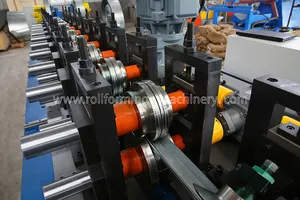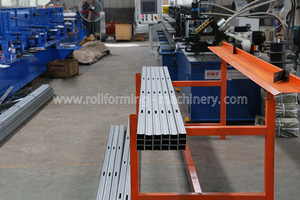
All categories
Featured selections
Trade Assurance
Buyer Central
Help Center
Get the app
Become a supplier

(9084 products available)




















































Market Overview: The global market for steel gutter making machines is part of the broader metal machining scrap equipment sector, which was valued at approximately $1.7 billion in 2023 and is projected to reach $2.0 billion by 2030, growing at a CAGR of 2.0% during this period, according to Research and Markets. This growth is primarily driven by the increasing demand for efficient waste management solutions in manufacturing operations, particularly in industries generating significant metal scrap. The rise in construction activities and the expanding automotive sector have also contributed to the demand for steel products, including gutters, which are essential for effective drainage systems. As sustainability becomes a focal point in manufacturing, the need for advanced machinery that can reduce waste and enhance recycling processes is more pronounced than ever.
Industry Insights: The competitive landscape for steel gutter making machines is influenced by a shift towards automation and technological advancements. Companies are increasingly investing in machinery that integrates smart technologies for predictive maintenance and operational efficiency. In the U.S., the metal machining scrap equipment market was estimated at $472.3 million in 2023, showcasing a robust demand for efficient scrap handling solutions. Meanwhile, China is projected to grow at a remarkable 4.1% CAGR, indicating a strong market for manufacturing equipment, including those for steel gutter production. Consumer behavior is also shifting towards eco-friendly solutions, compelling manufacturers to adopt practices that align with the increasing emphasis on sustainability. Overall, the steel gutter making machine market is poised for steady growth, driven by these key trends and consumer demands.
Due to the flexibility of steel gutter making machines, various types can be manufactured. Customization is also an option for industrial buyers to get specific designs for their business.
Automatic Steel Gutter Making Machines
Automatic steel gutter-making machines are fully automated systems that design, cut, shape, and assemble steel gutters independently. They usually have a programmable logic controller (PLC) and other automatic features to streamline manufacturing processes. High-speed operations are typical for these machines. Automatic steel gutter machines may come with various attachments and additions that allow multiple steel materials, such as aluminum and galvanized iron, to be used. These machines improve efficiency and productivity, resulting in lower labor costs and higher output.
Automatic Uncoiler
This automatic uncoiler is convenient when handling wide steel strips and reduces downtime by automatically unloading coiled strips. Coils can be held steadily with the uncoiler, which is connected to a roll forming machine to ensure a constant feed of the steel strip for creating gutters.
Roll Forming Machines
A roll forming machine is an automated steel gutter machine that uses multiple roller stations to change flat steel materials, such as sheets, into desired shapes and profiles. The steel strip is guided and continually shaped into various gutter profiles through different sets of rollers. The machine can manufacture a high volume of steel gutters in a consistent manner. It is also convenient since the roller stations are interchangeable to create various gutter shapes and sizes.
CNC Machines
CNC (Computer Numerical Control) machines are precise designs and cuts steel gutters according to computer programs. Adjustments can be made quickly when changing design requirements. A steel sheet is cut using a series of rollers and blades based on a predetermined program to create a steel gutter shape. The software integrated into these machines enhances manufacturing accuracy and efficiency. These machines can be ideal for creating complex or detailed steel gutter designs. An added perk of a CNC machine is that it reduces labor and time costs.
Combined Forming and Cutting Machines
A combined forming and cutting mini machine eliminates the need for multiple machines to create steel gutters. This machine is a compact solution that is convenient to set up and use. Automatically forming and cutting steel gutters will also improve productivity and efficiency.
Manual Steel Gutter Making Machines
The manual machines are portable and lightweight, making them handy when manufacturing steel gutters on-site. Manual machines are low-tech and require manual labor and physical tools to shape the steel material into a gutter. This includes manual cutting, bending, and assembling the steel material. While on-site, technicians can gather materials to construct seamless gutters on location.
The capability to produce various types of gutters is a notable specification of a gutter-making device.
Materials Compatibility
Some machines are capable of aluminum and plastic, while others are limited to only one type.
Production Rate
Machines with a higher production rate are mounted with more powerful motors and have rapid automated designs that enable efficient production.
Power Source
Power-driven means such as electric motors or hydraulic systems are included in this specification. Some manually operated machines have hand-cranked designs.
Dimensions
The dimensions and weight are included in the specifications. This is important because the machine must fit into a production space, and it must be moved easily by machinery or physically by workers.
Like all production devices, gutter-making machines require periodic maintenance to ensure efficiency, longevity, and consistent production at high quality. Routine, preventative maintenance is commonly used for reminder scheduling of machine maintenance. It includes prescribed periodic inspections, scheduled adjustments, routine cleaning, and lubrication of moving parts, as well as timely replacement of parts that are prone to wear and tear. In particular, it's important to maintain the machine's rolling component parts and its cutting system, where most of the wear from usage occurs.
V-belts require tension checks and small adjustments to ensure they are neither too tight nor too loose. All bolt fastenings should be securely fastened and checked for looseness. The guide rollers require cleaning and lubrication to ensure smooth pipe movement through the machine during the forming part of the process.
The cutting blade's sharpness requires regular inspection and possible dullness repair or replacement. Ensuring that blade guards are securely fastened is an important safety concern. Proper alignment of the cutting blade with the formed frame is necessary to ensure accurate cutting.
Adjustments required are usually minor as precision engineering ensures moving parts are aligned and fitted to fulfill specific functions. Yet, operators must learn the machine intimately so that minor adjustments can be made to ensure that it constantly produces pipes in accordance with the original specifications.
A steel gutter roll forming machine can be very useful in the following application scenarios.
Construction Companies
Construction companies use steel gutter forming machines to create gutters on-site. They do this because customizing gutters on-site makes it easier for them to install gutters that will fit.
Gutter Manufacturing Industry
The gutter manufacturing industry forms, produces, and supplies various gutters for multiple projects. These machines allow the industry to mass-produce standardized products quickly and efficiently.
Renovation and Remodeling Projects
When undertaking renovation or remodeling projects, contractors often need to change or add to existing gutter systems. They can do this by using the flexible and adaptive capabilities of a steel gutter-making machine.
Custom Gutter Shops
Custom gutter shops take advantage of steel gutter-making machines to create unique styles and designs according to the preferences and needs of individual customers.
Sign and Display Companies
Sign and display companies use steel gutter machines to make frames or stands for signs or displays. They use it to create a product that is durable and has the aesthetic appeal to the public.
Sustainability Initiatives
Many organizations and communities strive for sustainability and environmental responsibility. They often seek out rainwater harvesting systems as a practical solution. Steel gutters are durable and recyclable.
When choosing a steel gutter roll forming machine, the types of gutters the machine can make are the most important factor to consider. It is also essential to choose a machine that can manufacture the desired amount of gutters within the required timeframe. Additionally, the power source and technical features of the machine should also be taken into consideration in order to facilitate a smooth manufacturing process.
Since there are various types of steel gutters in the market, only a few of the most common gutter making machines are summarized in the table below.
Box gutter roll forming machine
A box gutter roll forming machine is used to produce internal box gutters. Internal box gutters are wide channels located within roof cavities that are designed to catch and direct water flow from the roof to rainwater downpipes. The main feature of this machine is its ability to create flanged gutters that can be easily fastened to the underside of a roof. Box gutters are more discreet than externally-braced eaves and can be used in situations where standard gutters would not be sufficient to manage the expected rainwater runoff.
Ibr gutter roll forming machine
An IBR gutter forming machine can be used to make the IBR steel gutter, which is often used with IBR roof sheets. An IBR roof sheet gutter is simple in design and allows for water to be drained efficiently. The IBR roof sheet is the same profile and can be fitted to the eaves where water will then run into the gutter. This type of gutter can be blended with the roofline, creating a clean and minimalist aesthetic. Additionally, the IBR gutter is not visible from the ground level, which is an advantage when dealing with planning regulations and compliance.
Half-round gutter forming machine
A half-round gutter forming machine is used to produce half-round gutters, which are commonly used in residential areas. Half-round gutters have an elegant rounded profile that resembles a semicircle. They are mounted below the roofline and catch rain as it falls from the roof. Specifically, traditional homes often incorporate architectural elements of the past, which may include the use of half-round gutters.
U-channel gutter roll forming machine
A U-gutter is a channel that is open on top and closed at the bottom with a semicircular bottom radius. This type of gutter allows water to flow freely without any obstructions, and it can be made in a variety of widths and depths depending on the application. The U-channel is often used for open drainage systems where water flow is constant, and there is a need for minimal maintenance. Furthermore, the U-gutter design permits high sidewalls which help to minimize water runoff splashes in the open field.
When selecting the gutter roll forming machine, apart from the type of gutters it makes, buyers should also take the machine's performance into consideration. The key performance criteria to consider include the machine's production speed, which is usually expressed in meters per minute, and its daily capacity, which indicates the manufacturer's efficiency. Additionally, the machine's material thickness range and cutting accuracy are also crucial factors to consider when making the decision.
Q1: What types of materials can a steel gutter roll forming machine work with?
A1: Generally, steel gutter forming machines are designed to accommodate various types of materials, including galvanized steel, carbon steel, stainless steel, and aluminum alloys.
Q2: What are the benefits of investing in a steel gutter making machine for a business?
A2: The machine offers a high level of automation, which can improve production efficiency. It also has the flexibility to produce different types of steel gutters, which can meet various market demands. More importantly, a steel gutter making machine can help a business reduce manufacturing costs by minimizing raw materials wastage and lowering labor costs.
Q3: What is the process of a steel gutter making machine?
A3: The machine's manufacturing process typically involves several steps, including feeding the material, preliminary forming, punching, longitudinal welding, final forming, cutting, and stacking.
Q4: What is the production capacity of a steel gutter making machine?
A4: The machine can manufacture up to 40 steel gutters per hour.
Q5: Can a steel gutter roll forming machine accommodate custom designs?
A5: Yes. A steel gutter forming machine can be configured with custom tooling to produce uniquely shaped gutters.